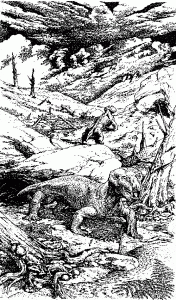Tetrapods across the PTB
At one time, it was suggested that tetrapods (amphibians and reptiles) were not much affected by the end-Permian mass extinction. In his standard textbook, Bob Carroll (1988) wrote:
The most dramatic extinction in the marine environment occurred at the end of the Permian, wiping out 95 percent of the nonvertebrate species and more than half the families. Surprisingly, there was not a correspondingly large extinction of either terrestrial or aquatic vertebrates.
It seemed unlikely that a mass extinction that acted so severely on life in the sea would be so limited in its effects on life on land. The end-Permian mass extinction, or Permo-Triassic boundary (PTB) event, dated at 252 million years (myr) ago, was the largest of all time, with the extinction of some 90-95% of all species on land and sea. Knowledge of the event has changed remarkably since 1990, with early exploration of putative extraterrestrial causes, such as meteorite impact (like the end-Cretaceous/ KT event) or a supernova. When Doug Erwin first reviewed the PT event (Erwin, 1993, 1994), he reflected the uncertainties of the time, not only about precisely what went extinct, but also about the timing of the event, and the possible causes. A comparison with the present state of affairs shows the changes in evidence. Where Erwin cites a duration of up to 8 Ma,the event is now known to have taken much less than 1 Ma. Where Erwin presents a general contrast of pre-extinction and post-extinction faunas in the sea, field studies have now provided millimetre-by millimetre precision in several parts of the world.
Where Erwin talks about a combination of possible environmental triggers, linked in part to long-term continental accretion, as well as to the eruptions, the current models look to the Siberian basalts plus explosive gas hydrate release. Where Erwin could say little about the nature of events on land, strong evidence now shows soil wash-off, extinction of most green plants, flushing of terrestrial debris into the oceans, and collapse of complex ecosystems. The changed views about the PT mass extinction are reflected in more recent books (Benton 2003, 2015; Erwin 2006).
Work in the Karoo Basin of South Africa (Ward et al. 2000) shows that extinctions were as severe on land as in the sea. The Karoo tetrapod beds have been studied intensively since the 1840s, and most attention has focused there. We believe that the Russian Permo-Triassic will offer a useful test of many hypotheses presented from study of the Karoo basin, and indeed may offer valuable additional data on precision of dating and environmental change.
The Russian faunas
Skeletons of amphibians and reptiles are found throughout the Late Permian rock sequence around the South Urals. The latest Permian fauna of Russia, the Vyatskian assemblage (see colour image below), known from the North Dvina river and from the south Urals, was richand diverse. Herbivores include the large pareiasaur Scutosaurus, a formidable hippo-sized animal covered in bony excrescences, and the large, smooth-skinned dicynodont Dicynodon, with its two expanded canine teeth and otherwise toothless jaws.
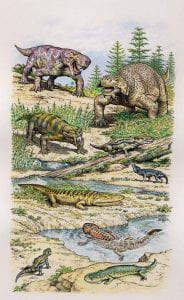 The Vyatskian assemblage of tetrapods, from the latest Permian. Artwork by John Sibbick. |
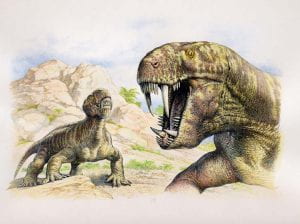 A latest Permian gorgonopsian from Russia, a sabre-toothed predator. Artwork by John Sibbick |
Carnivores include four species of gorgonopsians, including Inostrancevia, a great sabre-toothed reptile that presumably preyed on Scutosaurus and Dicynodon, as well as two smaller carnivores, a therocephalian and a cynodont. In other localities near Vyazniki, latest Permian reptiles include Archosaurus, a 1 m-long slender fish-eating reptile, oldest member of the Archosauria, or ‘ruling reptiles’ (the group that includes crocodiles and dinosaurs) and procolophonids, small triangular-skulled reptiles, related to pareiasaurs, but superficially looking somewhat like fat lizards. At the water’s edge were three or four species of amphibians.
Patterns of extinction
One of our key aims is to determine how life went extinct at the PTB. Practically, we cannot hope to collect enough specimens of amphibians and reptiles ourselves from the Russian PT succession. However, Valentin Tverdokhlebov has kept an elaborate card index file of every tetrapod specimen – whether complete skeletons or skulls, or isolated bones – over the past fifty years of his work in the Orenburg area. In this, he documents 675 specimens from 289 localities in the entire PT red-bed area of exposure from Buzuluk to Saraktash, some 400 km from west to east and 200 km from north to south. The locality records are each assigned to one or other of the 13 stratigraphic divisions into which the Late Permian and Early to Middle Triassic succession is divided (Figure below).
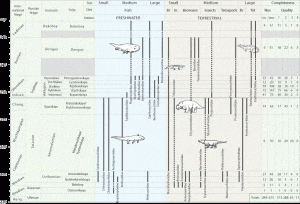 Available as the original pdf image for download. Drawn by Simon Powell (please acknowledge). |
We were first shown the card index in 1995, and then, after careful checking, we published it as two papers, one on the Early to Middle Triassic localities and faunas (Tverdokhlebov et al. 2003) and one on the Late Permian localities and faunas (Tverdokhlebov et al. 2005). These papers provide the first thorough account of the Russian terrestrial Permo-Triassic red-bed succession in any language, whether Russian or English, and they should set right a major omission in the literature. The equivalent successions in the Karoo basin in South Africa have been extensively documented over the years, but the Russian rocks and fossils have been reported only rarely, partly because the field geological data were considered a part of the mapping programme by the Soviet authorities, and so were top secret!
Our statistical analysis of the data (Benton et al. 2004) showed some of the complexity of the extinction event (Figure above). There were seven families of amphibians and 15 families of reptiles in the Late Permian of Russia, some of them rather short-lived, and others extending through the entire time span. In each of the six Middle and Late Permian faunas, in the rivers and lakes, four to seven genera of small, medium and large aquatic tetrapods (‘amphibians’) fed on the abundant thick-scaled bony fishes and rarer freshwater sharks and lungfishes. On the wooded banks were five to eleven genera of terrestrial tetrapods (‘reptiles’), ranging in size from tiny insect-eaters to rhino-sized plant-eating pareiasaurs and the wolf- to bear-sized, sabre-toothed gorgonopsians that fed on them.
Twenty of the 22 Middle and Late Permian families went extinct at, or before, the PTB, and only two – the small, mainly herbivorous procolophonids and the larger herbivorous dicynodonts – survived through the mass extinction. Of the 22 families, 11 were present at the end of the Vyatskian interval, the terminal Russian Permian time unit, and the extinction of nine of these corresponds to a family-level extinction rate of 82%. This is high when compared with the global family-level extinction rate of 55% or so for marine families (Sepkoski 1997) and it scales, of course, to a much higher rate of extinction at generic or specific levels.
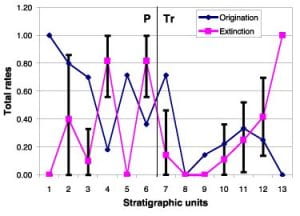 Turnover of tetrapod families through the Late Permian and Early Triassic in the South Urals Basin, Russia. Rates of origination and extinction are percentage metrics based on all taxa (including Lazarus taxa, but excluding singleton families – families known from a single species or single locality) known from a time bin. Stratigraphic units are the successive svitas of the Upper Permian (1, Osinovskaya; 2, Belebey; 3, Bolshekinelskaya; 4, Amanakskaya; 5, Malokinelskaya/ Vyakovskaya; 6, Kutulukskaya/ Kulchomovskaya), Lower Triassic (7, Kopanskaya; 8, Staritskaya; 9, Kzylsaiskaya; 10, Gostevskaya; 11, Petropavlovskaya) and Middle Triassic (12, Donguz; 13, Bukobay). Binomial 95% confidence intervals are shown for the percentage extinction metrics (confidence intervals are of similar magnitude for the percentage origination metrics, but are omitted for clarity). (From Benton et al. 2004.)
Turnover of tetrapod families through the Late Permian and Early Triassic in the South Urals Basin, Russia. Rates of origination and extinction are percentage metrics based on all taxa (including Lazarus taxa, but excluding singleton families – families known from a single species or single locality) known from a time bin. Stratigraphic units are the successive svitas of the Upper Permian (1, Osinovskaya; 2, Belebey; 3, Bolshekinelskaya; 4, Amanakskaya; 5, Malokinelskaya/ Vyakovskaya; 6, Kutulukskaya/ Kulchomovskaya), Lower Triassic (7, Kopanskaya; 8, Staritskaya; 9, Kzylsaiskaya; 10, Gostevskaya; 11, Petropavlovskaya) and Middle Triassic (12, Donguz; 13, Bukobay). Binomial 95% confidence intervals are shown for the percentage extinction metrics (confidence intervals are of similar magnitude for the percentage origination metrics, but are omitted for clarity). (From Benton et al. 2004.)
The pattern of familial and generic extinction in Russia is similar to that already known from other PT sections, in South Africa and South America, for example. However, the pattern of extinction and origination before the boundary was a little surprising. Indeed, the families and genera showed seemingly erratic behaviour, with repeated peaks in extinction and origination (see Figure above). As a supposedly stable Late Permian ecosystem, it might have been assumed that there would have been relatively little turnover of families and genera. But, of course, no genus or species lasts for ever, and it is quite expected that a mature and stable ecosystem would show such turnover patterns through a time span of 10-15 Ma.
Recovery and postural shift across the PTB
The recovery from the mass extinction seems to have taken some time for the Russian tetrapods. In addition, Kubo & Benton (2009) noted an astonishing observation: Permian tetrapods were sprawlers, and Triassic tetrapods were upright in posture and gait. It seems that the mass extinction had an astonishing effect on both the diapsid and synapsid lines of tetrapods, whose posture evolved in parallel – a kind of ancient ‘arms race’ between predators and prey. Read more here.
References
- Benton, M.J. 2003. When life nearly died: the greatest mass extinction of all time. Thames & Hudson, London.
- Benton, M.J., Tverdokhlebov, V.P. and Surkov, M.V. 2004. Ecosystem remodelling among vertebrates at the Permian-Triassic boundary in Russia. Nature 432, 97-100 (doi:10.1038/nature02950). pdf Download the original of Figure 1 in colour as a pdf. Download the Excel data file here.
- Carroll, R.L. 1988. Vertebrate paleontology and evolution. W. H. Freeman, San Francisco.
- Erwin, D.H. 1993. The great Paleozoic crisis: Life and death in the Permian. Columbia University Press, New York.
- Erwin, D.H. 1994. The Permo-Triassic mass extinction. Nature, 367, 231-236.
- Erwin, D.H. 2006. Extinction: How life on Earth nearly ended 250 million years ago. Princeton University Press, Princeton.
- Kubo, T. and Benton, M.J. 2009. Tetrapod postural shift estimated from Permian and Triassic trackways. Palaeontology 52, 1029-1037. pdf. Interpretive web site.
- Sepkoski, J. Jr 1997. Biodiversity: past, present, and future. Journal of Paleontology, 7, 533-539.
- Tverdokhlebov, V.P., Tverdokhlebova, G.I., Minikh, A.V., Surkov, M.V., and Benton, M.J. 2005. Upper Permian vertebrates and their sedimentological context in the South Urals, Russia. Earth-Science Reviews, 69, 27-77. pdf
- Tverdokhlebov, V.P., Tverdokhlebova, G.I., Surkov, M.V., and Benton, M.J. 2003. Tetrapod localities from the Triassic of the SE of European Russia. Earth-Science Reviews 60, 1-66. pdf
- Ward, P.D., Montgomery, D.R. & Smith, R.H.M. 2000. Altered river morphology in South Africa related to the Permian-Triassic extinction. Science, 289, 1741-1743.


